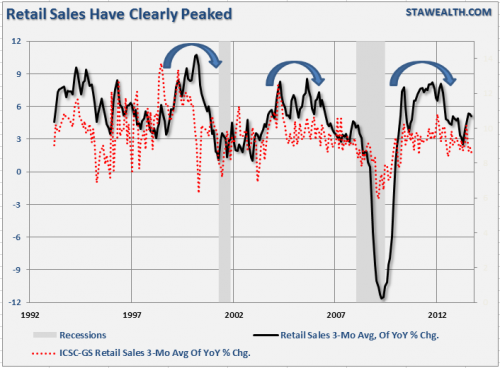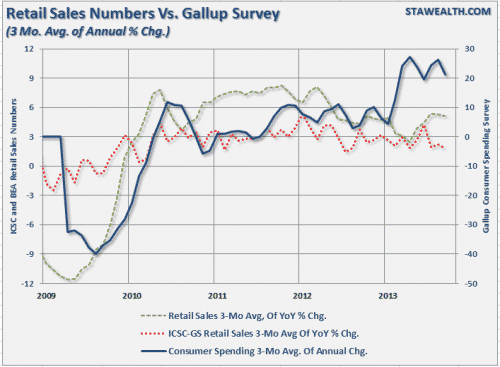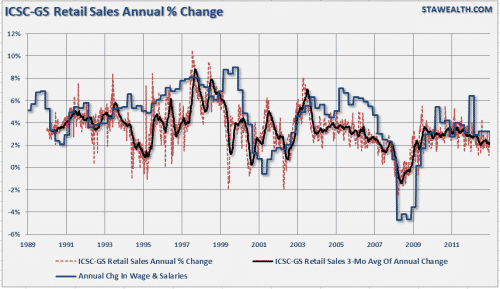Has US retail sales growth peaked?
During the government shutdown, the data for a variety of economic reports were halted. Therefore, I looked at alternative, private sector, data to estimate the government reports. One such model used the historical differential between the ADP and BLS employment reports to estimate the jobs created in September. That model was off by only 3,000 jobs. I also estimated that retail sales would likely slow in September due to the data being issued by the ICSC-Goldman Sachs.
“The recent weakness in both surveys suggest that we may see a decline in the government retail sales and personal consumption data when they are eventually released as well.”
The retail sales report for September did indeed show weakness coming in at a -0.1 as automobile sales sagged. Core retail sales, once automobiles and gasoline are stripped out, rose 0.4% in September as consumers, amazingly enough, still have to spend money to live on silly things like food, energy and healthcare. Unfortunately, if you look at the retail sales data on a “not seasonally adjusted” basis, there is a record drop in sales for any month of September on record. Regardless of how you choose to analyze the monthly data the reality is that such month to month data is effectively useless in determining the overall strength or direction of the economy. This is why I prefer to use annualized rates of change in the data to more clearly see the data trends that are developing.
The most recent retail sales report continues to show that, despite a short-lived burst in activity, retail sales peaked in 2011 and has been slowing since. This is not uncommon given the length of the current economic recovery. The chart below compares the 3-month average of the annual rate of change of both the government reported retail sales data versus the ICSC-Goldman Sachs retail sales data. [Note: I am using the 3-month average of the annual rate of change to smooth the very volatile weekly data of the ICSC report for a better comparison to the monthly retail sales report.]
The next chart shows adds the private Gallup Consumer Spending survey to the data above since the end of the recession.
The jump in the Gallup Consumer Spending survey at the beginning of 2013 likely has much to do with bonuses and payouts that were made in response to the “fiscal cliff” fiasco. Since that time spending intentions have leveled out. However, what is clear is that actual spending, versus expectations to spend, have clearly softened.
This is an important dynamic as we see corporate earnings weaken as 75% of reported guidance, so far, being negative. However, there is one dynamic that has yet to fall into most analysts radars – the impact of the Affordable Care Act.
Just recently CNBC aired the following interview with two women discussing the costs of their “new” health care plans.
These are not “one-off” cases but more of the norm that we are witnessing from a variety of sources. With the new revelation that as many as 14 million healthcare plans will be cancelled; the number of individuals having to pay more for healthcare is increasing.
What does this have to do with retail sales? Just about everything. The chart below compares the level of retail sales to personal incomes. See the correlation?
Those incomes are not rising. If we substract an additional $200-300 per month for the additional cost of governmental healthcare – where does the money come from? The problem for the average American is that their income is very finite. According to a recent CNN Money survey roughly three-fourths of all American’s are already living paycheck to paycheck. Of course, this should not be surprising with roughly 90% of the population earning less than $50,000 on average.
That increase in the cost of healthcare, combined with the increased taxes from the ACA itself, will have a negative impact on both retail sales and the more comprehensive personal consumption expenditures report which feeds directly into the GDP calculation.
I specially stated in January of this year:
“As stated above there is very little ‘wiggle room’ for the economy at this point to absorb much of a shock. With real final sales plugging along at 1.9%, and the output gap above 6%, the slack in the economy is huge. As a reminder, these numbers are generally levels more associated with recessions and not four years into a recovery.
Of course, the fact the economy can run at such subpar growth rates without technically being in a recession is a function of the ‘new normal’ of an economy supported by trillions of dollars of stimulus. This also goes a long way to support the idea that recent claims that the economy is on the verge of acceleration in growth are likely based more on ‘hope’ than ‘reality.’ The economy will likely continue to ‘muddle along’ only as long as the Federal Reserve continues to support it by artificially suppressing interest rates and flooding the system with liquidity.”
Therein lies the greatest problem for investors. As asset prices continue to surge to all time highs the underlying fundamentals continue to soften. Such divergences do not last forever and have historically tended to end very badly. However, while understanding and quantifying the risks that exist is important, these divergences can last much longer than logic reasonably suggests. As Howard Marks once stated; “Being early, even if you are right, is the same as being wrong.”
Currently, there is no end in sight for the Federal Reserves monetary initiatives, and as one analyst stated on CNBC this morning, there are two reasons to be invested in stocks currently; 1) $85 billion a month, and; 2) no talk of “taper.” Of course, with that kind of logic, what does one have to lose?



Comments are closed.